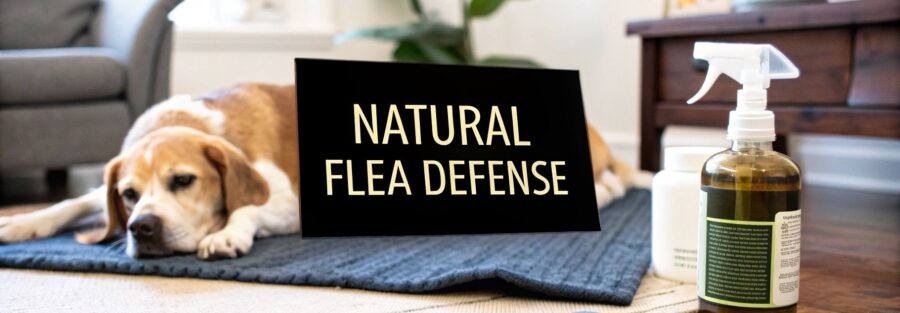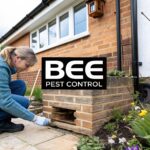Choosing a natural flea treatment often means stepping away from harsh chemicals and opting for safer, gentler alternatives for your pet and home. This isn't just a trend; it's a conscious decision driven by real concerns over the environmental and health impacts of the conventional pesticides found in so many spot-on products.
Why Pet Owners Are Choosing Natural Flea Treatments
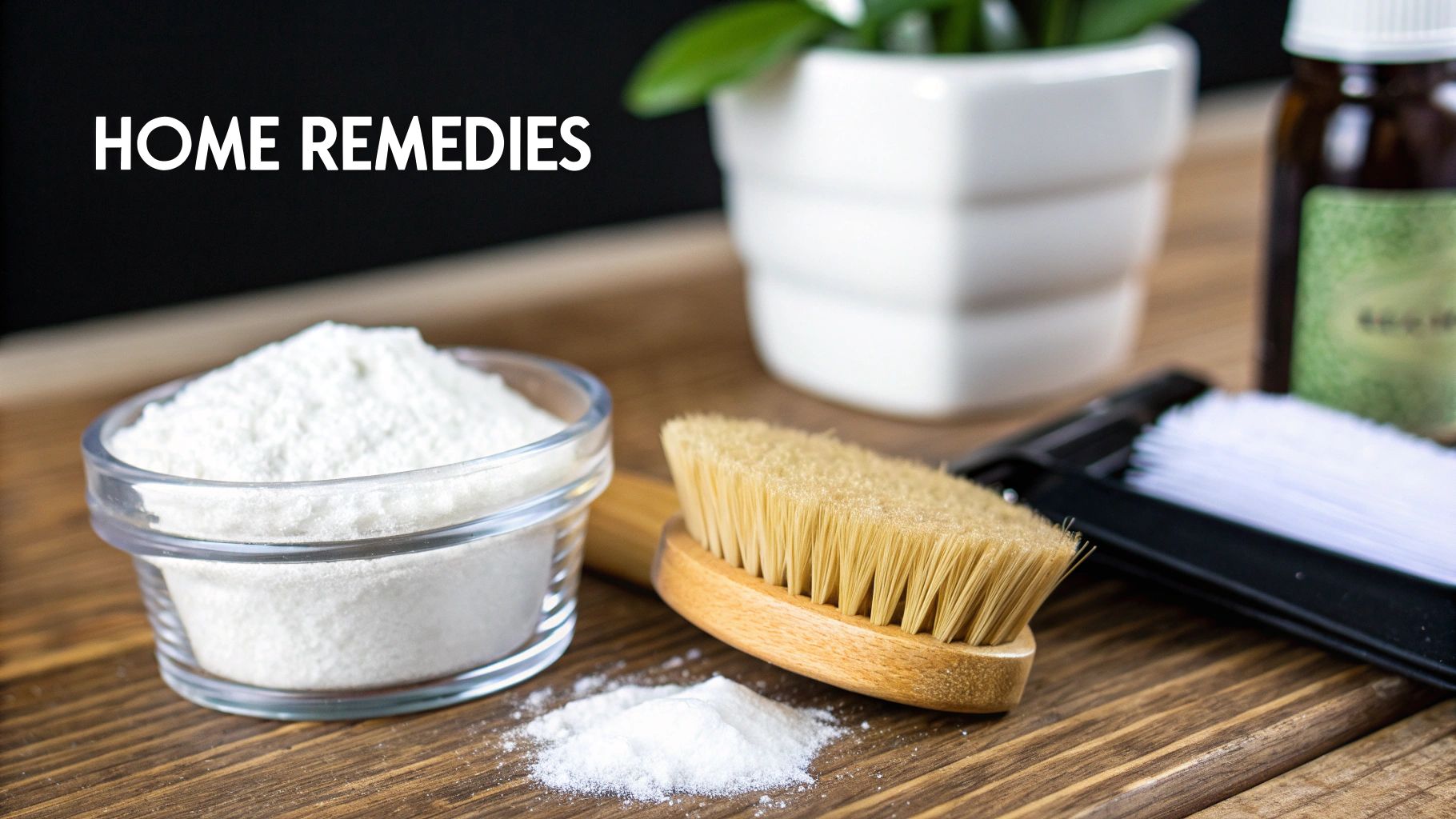
More and more pet owners are taking a closer look at the ingredients in the products they use. The standard flea treatments lining pet shop shelves often contain potent insecticides. While they’re certainly effective at killing fleas, the long-term effects of these chemicals on our pets, our families, and the wider environment are a growing cause for concern.
This shift towards natural options is rooted in a desire for safer, more sustainable pet care. When you choose a natural approach, you’re taking back control of what goes onto your pet's skin and into your home.
The Environmental Impact of Chemical Treatments
The active ingredients in many widely-used veterinary flea products are powerful pesticides. Two of the most common, fipronil and imidacloprid, have come under intense scrutiny for their environmental persistence and damage.
It's quite surprising to learn that while these neurotoxic insecticides are banned for agricultural use in the UK to protect vital pollinators like bees, they’re still permitted in veterinary medicines. This double standard raises some serious questions about how these substances are finding their way into our ecosystem.
When you treat your pet, these chemicals don't just stay on their fur. They wash off during baths, get shed with hair, and can even enter waterways if your dog goes for a swim. This creates a direct pathway from your living room to our rivers.
Recent studies have confirmed just how widespread this problem is. Worries about environmental contamination have grown as these chemicals are increasingly detected in UK waterways. In fact, a government roadmap is now targeting fipronil and imidacloprid, acknowledging their presence in our rivers and streams. The evidence points to treated pets as a primary source, with the chemicals entering freshwater ecosystems through washing, excretion, and swimming.
This contamination poses a real threat to aquatic insects and, in turn, the fish and birds that depend on them, disrupting entire ecosystems.
Prioritising Your Pet's Wellbeing
Beyond the environmental impact, many owners simply aren't comfortable applying strong pesticides directly to their pets' skin month after month. Some animals, especially those with sensitive skin, can have adverse reactions to chemical treatments.
These can include:
- Skin irritation or redness where the product was applied
- Lethargy or noticeable changes in behaviour
- In rare cases, more severe neurological symptoms
By choosing a natural flea treatment, you can sidestep these potential side effects. Natural remedies often use ingredients like diatomaceous earth, apple cider vinegar, or specific essential oils. They work by repelling fleas or dehydrating them, rather than relying on potent chemical action. While these methods often require a bit more consistency, they offer invaluable peace of mind.
Ultimately, the move towards natural solutions reflects a broader, more conscious approach to pet care. It’s about making informed decisions that protect not only our beloved animal companions but also the world we all share. Of course, a severe infestation might still need a more robust intervention, and that’s where professional https://www.pestpredatorslimited.co.uk/pest-control-services/ can provide crucial guidance. But for prevention and management, a natural approach offers a powerful and safe first line of defence.
How to Spot a Flea Problem on Your Pet and in Your Home
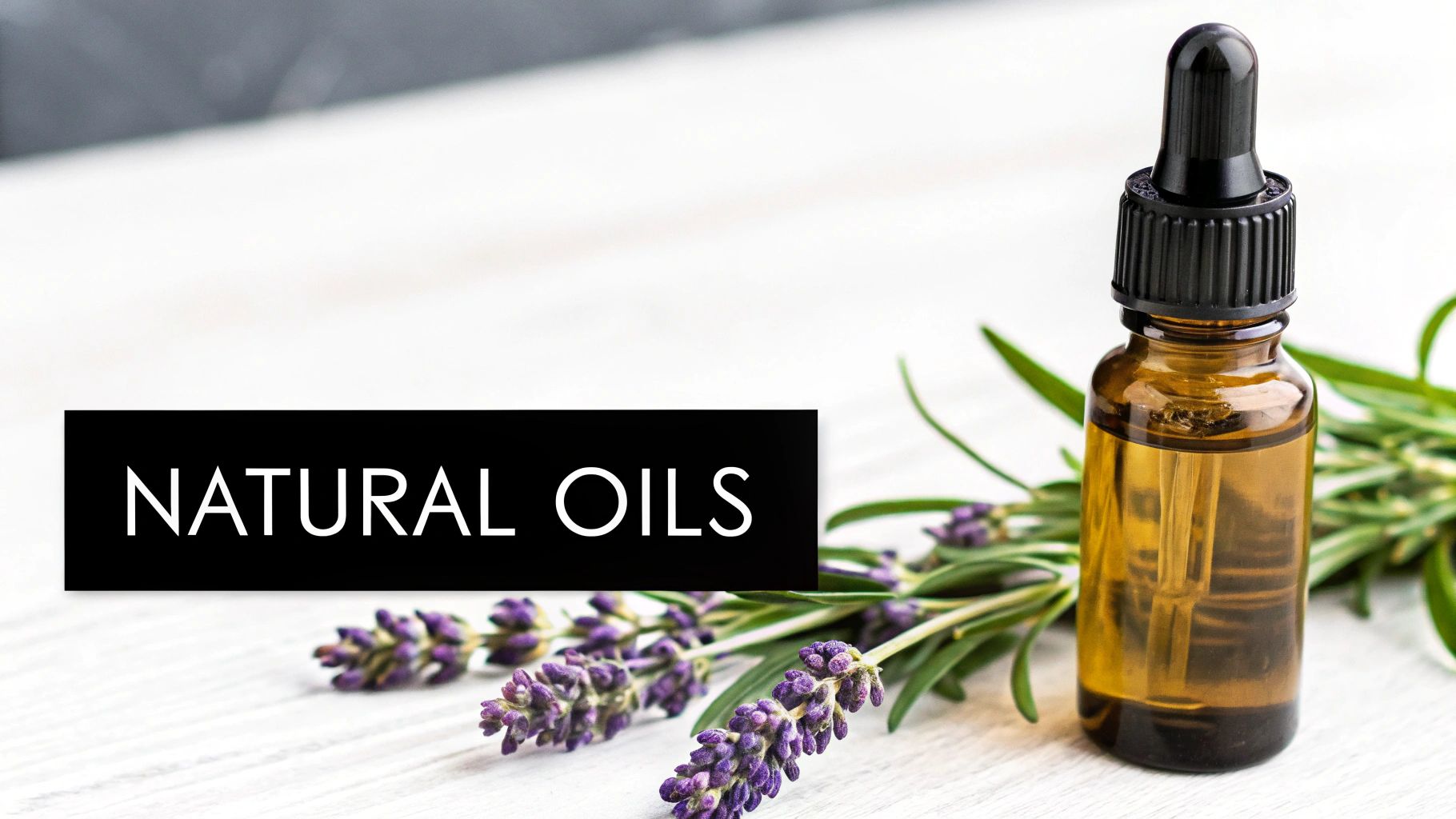
Before you can tackle the problem, you need to be certain you're fighting the right foe. Spotting a flea problem early is about more than just seeing your pet scratch – it’s about preventing a small issue from becoming a massive headache.
An adult flea can lay up to 50 eggs per day, so a single unwanted guest can quickly turn into a full-blown infestation that takes over your pet and your home.
The trick is to look for both direct and indirect evidence. You might occasionally see a tiny, dark brown flea darting through your pet's fur, but they’re lightning-fast and surprisingly difficult to catch. More often than not, the clues they leave behind are the first real sign that something's wrong.
Uncovering Evidence on Your Pet
The most obvious giveaway is persistent scratching, biting, or licking. You might notice your dog suddenly chewing at the base of its tail or your cat grooming itself obsessively. This is often just a reaction to the irritation of flea bites.
However, for some pets, it can signal a more serious problem known as flea allergy dermatitis (FAD), which is an allergic reaction to flea saliva.
If you have your suspicions, a couple of simple checks will give you a clear answer.
- A Visual Inspection: Gently part your pet’s fur in a few different places. Pay close attention to the hotspots – the lower back, base of the tail, groin, and around the neck. You’re looking for either live fleas or small, red, irritated bumps from recent bites.
- The White Paper Test: This is one of the most reliable methods I know. Get your pet to stand on a white sheet of paper or a white towel, then give their coat a vigorous brush. If tiny black specks fall onto the paper, it could be "flea dirt" (which is really flea poo). To be sure, sprinkle a little water on the specks. If they dissolve into reddish-brown streaks, you've found your proof.
Why Your Home Is the Real Battlefield
Finding fleas on your pet is just the tip of the iceberg. I can't stress this enough: the adult fleas you see on your animal make up only about 5% of the total flea population.
The other 95% is hiding in your home as eggs, larvae, and pupae. They’re lurking in your carpets, tucked into your furniture, nestled in bedding, and even hidden between your floorboards.
This is the most critical fact to understand about flea control: treating only your pet will never solve the problem. To succeed with any flea treatment, natural or not, you must break the entire flea life cycle by tackling the infestation in your home as well.
This hidden majority is exactly why infestations seem to reappear just when you think you’ve won. A quick vacuum or washing the dog's bed simply isn't enough. The pupae stage is especially tough; they can stay dormant for months, just waiting for the right conditions—like warmth, vibrations, or the carbon dioxide from a passing pet—to hatch and start the nightmare all over again.
Spotting the problem on your pet is the first step, but realising your home is the main front is the key to winning this war.
Safe and Effective Natural Remedies for Your Pet
Now that you’ve spotted the enemy, it’s time to go on the offensive. Applying a natural flea treatment directly to your pet is a brilliant way to tackle the problem, but it has to be done with care. This isn’t about dousing your furry friend in random concoctions; it’s about using gentle, proven remedies that work with your pet’s sensitive system, not against it.
Many of us have had great success with simple, homemade sprays. They work by making your pet's coat an awful place for fleas to be, encouraging them to jump off or avoid latching on in the first place.
Creating Gentle Flea Repellent Sprays
One of the best and most popular bases for a natural spray is apple cider vinegar. Fleas absolutely hate its acidic nature, but it’s generally very gentle on a pet's skin when you dilute it properly.
Just mix equal parts raw, unfiltered apple cider vinegar and water in a spray bottle. Before your pet heads outside, give their coat a light mist, focusing on their back, legs, and tummy. Be very careful to avoid their eyes or any little cuts or sores.
Another fantastic option is a simple lemon-infused water spray. Lemons contain a compound called limonene, which is a well-known natural flea repellent.
- Slice one or two lemons thinly and pop them in a pot.
- Cover the slices with about half a litre of water and bring it to a boil.
- Once it’s boiling, take it off the heat and let it steep overnight.
- The next day, strain the liquid into a spray bottle, and you're ready to go.
A quick word of advice from experience: always do a small patch test on your pet's skin 24 hours before you spray them all over. This simple step helps make sure they won't have a bad reaction, no matter how natural the ingredients are.
The Power of Mechanical Removal
Never, ever underestimate the effectiveness of a good old-fashioned flea comb. This hands-on method gives you immediate results and is completely safe for pets of all ages, even tiny puppies and kittens. It's a fantastic natural flea treatment on its own or alongside other methods.
Combing should be a slow, methodical job. Really focus on the places fleas love to hide, like around the neck, the base of the tail, and the warm groin area. Keep a small bowl of soapy water next to you. When you catch a flea on the comb, dunk it straight into the water to drown it. This is a crucial step—fleas can jump incredible distances and will get away if you just try to crush them.
Using Essential Oils with Extreme Caution
Essential oils can be powerful flea repellents, but you have to handle them with extreme care. What might be safe for a human or even a dog can be highly toxic to a cat. This is because cats lack a specific enzyme in their liver that helps them metabolise certain compounds, making them incredibly vulnerable.
For dogs, a few specific oils are generally considered safer when heavily diluted:
- Cedarwood Oil: Known for its ability to repel fleas and other insects.
- Lavender Oil: Can help repel fleas and often has a calming effect.
- Lemongrass Oil: A very effective repellent, but you must use it in tiny, diluted amounts.
A safe dilution is non-negotiable. Add just one or two drops of a pet-safe essential oil to a full spray bottle of water. Shake it vigorously before every use, as oil and water don't mix. Never apply undiluted essential oils directly to your pet's skin.
It is absolutely critical to avoid certain oils, especially if you have cats in the house. Tea tree, pennyroyal, wintergreen, and citrus oils (in concentrated form) are toxic and should never be used on or around your feline friends.
For a quick overview of what's what, here's a handy reference guide to some of the most common natural options.
Pet-Safe Natural Flea Repellent Options
| Natural Ingredient | Method of Application | Safe for Dogs? | Safe for Cats? | Important Notes |
|---|---|---|---|---|
| Apple Cider Vinegar | Diluted 1:1 with water in a spray bottle. | Yes | Yes | Avoid contact with eyes and open wounds. Best used before outdoor activity. |
| Lemon Infusion | Water steeped with boiled lemons, used as a spray. | Yes | Yes | A gentle option, but always patch test first. The active ingredient is limonene. |
| Cedarwood Oil | Heavily diluted (1-2 drops per spray bottle of water). | Yes | No | Highly toxic to cats. Use with extreme caution and ensure proper dilution for dogs. |
| Lavender Oil | Heavily diluted (1-2 drops per spray bottle of water). | Yes | No | Toxic to cats. Some dogs may be sensitive, so a patch test is essential. |
| Flea Comb | Manual combing through the fur. | Yes | Yes | The safest method. Use with soapy water to drown fleas immediately. |
This table shows that while some remedies are great for both dogs and cats, others carry serious risks. Always double-check what's safe for your specific pet.
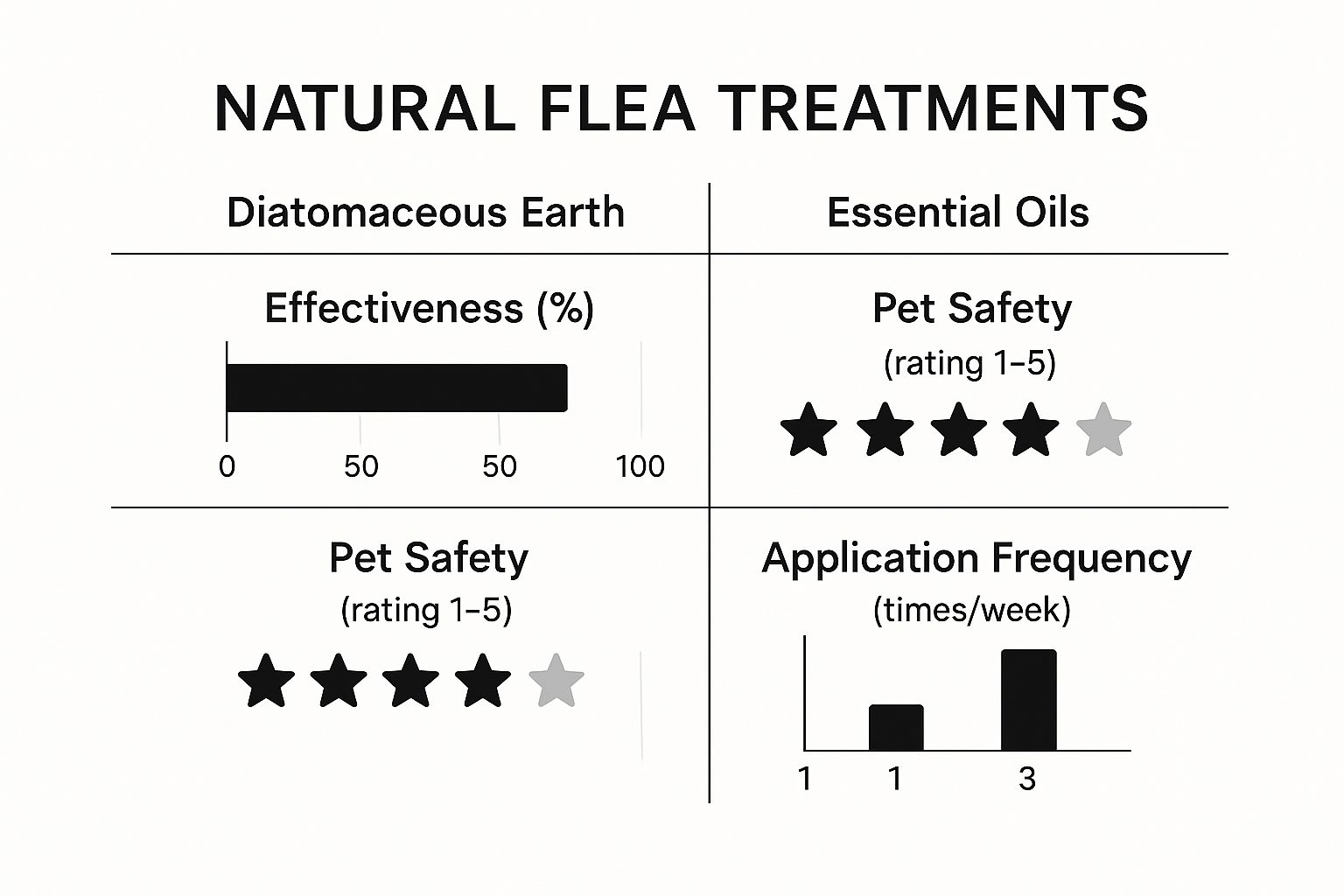
The importance of using genuinely safe products can’t be overstated. Here in the UK, safety fears have grown due to an alarming rise in counterfeit flea products sold online. In fact, the UK government even issued an urgent warning after fake treatments containing toxic pesticides caused severe poisoning in a cat, which tragically needed emergency surgery.
This scary situation just reinforces why so many of us are now seeking reliable, natural alternatives to protect our companions from both hidden chemical risks and fraudulent products.
Creating a Flea-Proof Home Environment
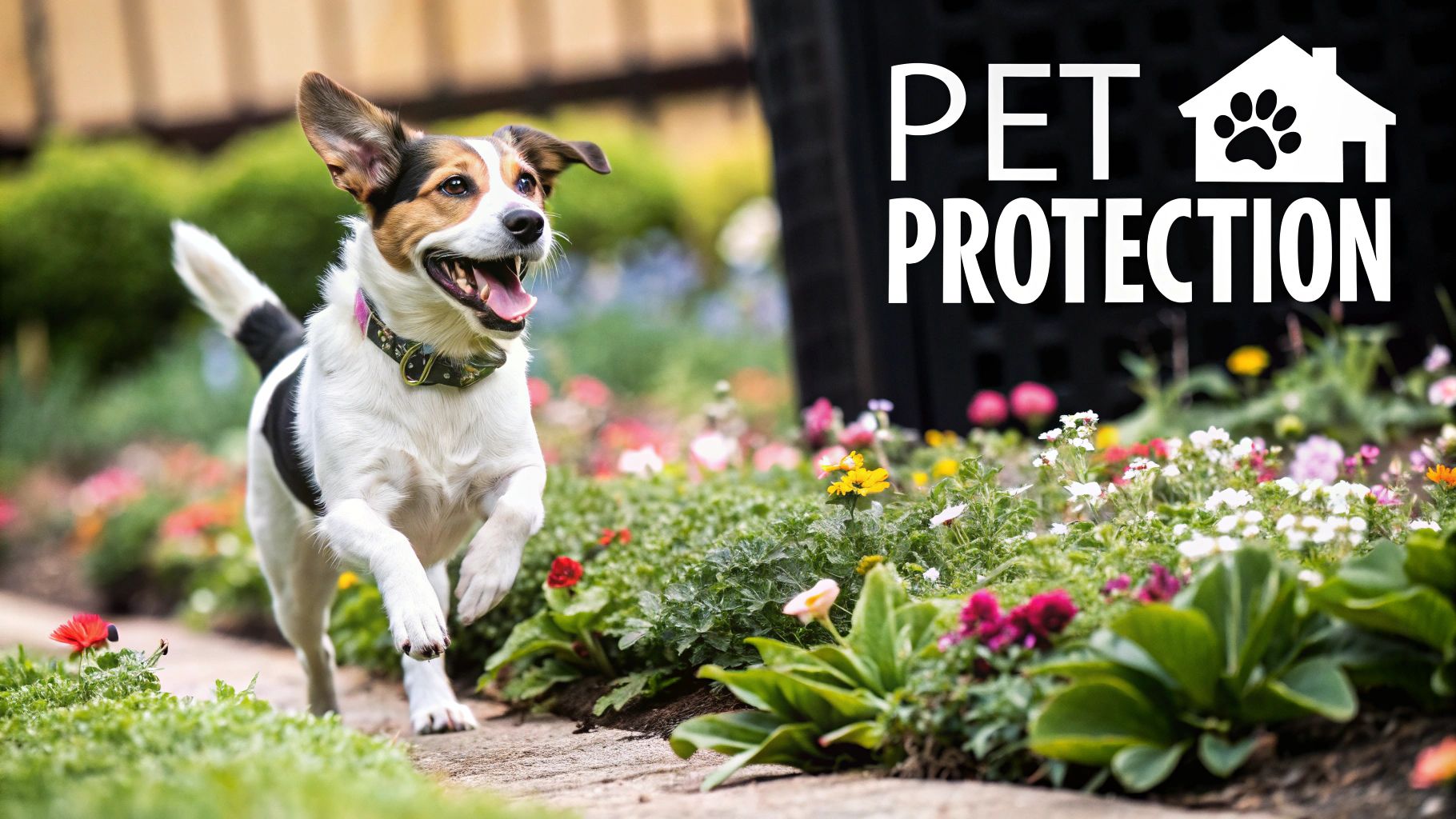
Treating your pet is a vital first step, but honestly, it’s only a fraction of the battle. If you want to win the war on fleas, you have to reclaim your home. This is where over 95% of the flea population—the eggs, larvae, and pupae—is hiding in plain sight.
Winning this war means being methodical and relentless. You need to focus your efforts on the areas where fleas and their offspring thrive, turning your living space from a flea nursery into a hostile environment for these pests.
Your Most Powerful Weapon is the Vacuum Cleaner
It might sound too simple, but your vacuum cleaner is the single most effective tool in your flea-fighting arsenal. A good, thorough vacuuming does more than just suck up adult fleas; its vibrations are the real secret weapon.
Those vibrations actually mimic the presence of a potential host—your pet—which cleverly tricks the flea pupae into hatching. This is a huge advantage, as the pupal stage is notoriously tough to kill. By forcing them to emerge, you can suck them up before they ever get a chance to jump on your pet.
For this to work, you need a plan:
- Be Thorough: Vacuum everything. That means all carpets, rugs, and upholstered furniture. Don't forget to use the crevice tool to get deep into sofa cushions, along skirting boards, and under furniture where debris collects.
- Target Hotspots: Pay extra attention to the spots where your pet loves to sleep or hang out. These areas will have the highest concentration of flea eggs and larvae.
- Dispose Carefully: This part is critical. As soon as you finish, take the vacuum bag outside, seal it in another plastic bag, and put it straight into your outdoor bin. For bagless models, empty the canister outside and give it a good wash with hot, soapy water.
This isn’t a one-and-done job. During an active infestation, you should be vacuuming daily to keep on top of newly hatched fleas and completely break their life cycle.
Using Desiccants to Dry Out Flea Strongholds
Once you've vacuumed, it's time to treat your carpets and soft furnishings with a natural desiccant. These are substances that kill fleas, eggs, and larvae by absorbing the oils and fats from their bodies, effectively dehydrating them.
One of the best natural options is food-grade diatomaceous earth (DE). This is a fine powder made from fossilised algae. Its microscopic sharp edges cut through a flea’s waxy outer layer, causing it to dry out and die.
When using DE, safety is key. You absolutely must use food-grade DE, as the industrial version for swimming pools is harmful if inhaled. Even with the food-grade stuff, it's a good idea to wear a mask during application to avoid irritating your lungs.
Simply sprinkle a light, even layer of food-grade diatomaceous earth over your carpets, rugs, and pet bedding. Use a brush to gently work it deep into the fibres, then leave it for at least a few hours—or even overnight—before vacuuming it all up thoroughly.
Baking soda and salt are two other effective desiccants you probably already have in your kitchen cupboards. They work in a similar way. Just create a mixture of equal parts salt and baking soda, sprinkle it into your carpets, let it sit for several hours, and then a final, thorough vacuum will lift the powder along with any dehydrated flea eggs and larvae.
The Critical Importance of Hot Water Washing
Your washing machine is another key ally in this fight. Fleas and their eggs simply can't survive high temperatures, making a hot wash a non-negotiable step.
Gather up all your pet's bedding, blankets, soft toys, and any washable covers from sofas or cushions. Wash everything on the hottest cycle your machine and the fabrics can handle.
For items that can't be washed, a hot tumble dryer can be just as effective. Popping them in for 20-30 minutes is usually enough to kill all stages of the flea life cycle.
This needs to become a regular habit—at least once a week during an infestation—to make sure you're getting rid of any newly laid eggs before they get a chance to hatch. This methodical cleaning, combined with your other efforts, creates a fantastic defence system. By managing your home environment, you're not just dealing with fleas; you're also creating a cleaner, healthier space for everyone.
If you're looking for more tips on keeping your home pest-free, our guide on general fly control offers other useful strategies that can be applied to various household pests.
Building Your Pet's Natural Defences From the Inside Out
While topical sprays and home treatments are crucial for knocking down an active flea problem, true, long-term prevention starts from within. A strong, healthy pet is simply a less appealing target for parasites. Building this internal resilience is a powerful, proactive strategy that bolsters their overall wellness and cuts down on the need for constant chemical intervention.
The idea is to optimise your pet's health so their skin and coat become inhospitable territory for fleas. This really comes down to their diet and grooming habits, turning everyday care into a formidable line of defence. It’s all about creating a foundation of health so robust that fleas struggle to get a foothold in the first place.
The Role of Diet in Flea Prevention
What you put in your pet's bowl has a direct impact on the health of their skin and coat. A high-quality, species-appropriate diet rich in essential fatty acids, vitamins, and minerals is the cornerstone of a strong immune system. When a pet's skin is healthy, it's less prone to the dryness and irritation that can make them an easy meal for fleas.
Beyond a balanced diet, certain supplements can offer an extra layer of protection. One of the most well-known is brewer's yeast. Rich in B vitamins (especially B1, or thiamine), it's thought to produce a subtle scent through the skin that fleas absolutely hate.
When you're thinking about adding supplements, remember a few key things:
- Start Small: Introduce brewer's yeast gradually into your pet's food. A good rule of thumb is about half a teaspoon per 10kg of body weight, but always have a chat with your vet first.
- Look for Quality: Make sure you're using a product specifically formulated for pets. This guarantees the right dosage and purity.
- Be Patient: This isn't an instant fix. It can take several weeks of consistent use for the effects to build up in your pet's system.
A strong internal system makes your pet less reliant on external treatments. This is more important than ever, especially when you consider the environmental impact of conventional options. The UK's pet population, with an estimated 10 million dogs and 11 million cats, contributes significantly to chemical pollution. Around 80% of these pets receive regular treatments, leading to pesticides like fipronil and imidacloprid being found in rivers at unsafe levels. You can read more in the analysis by The Rivers Trust about how pet treatments are affecting England's rivers.
Grooming as a First Line of Defence
Regular grooming is so much more than just keeping your pet looking neat; it's one of the most effective physical methods of flea control you have. A consistent grooming routine is your chance to conduct a full-body inspection, catching potential problems long before they explode into a full-blown infestation.
Think of it as your daily health check. Brushing removes loose fur and debris that can hide flea eggs and larvae. More importantly, it gives you the chance to spot flea dirt or live fleas early on.
Regular grooming sessions also strengthen your bond with your pet. By making it a positive and routine experience, you can check them for fleas, ticks, lumps, and bumps without causing any stress.
For the best results, integrate a fine-toothed flea comb into your grooming schedule. Even if you don't suspect fleas, a quick comb-through a few times a week can catch any stray parasite that has hitched a ride. This simple, hands-on approach gives you immediate feedback on whether your natural flea strategy is working, allowing you to be proactive—not just reactive—in keeping your companion comfortable and flea-free.
Common Questions About Natural Flea Control
Deciding to go the natural route for flea treatment is a great move, but it’s completely normal to have a few questions before you jump in. Most pet owners I talk to are curious about the same things: how fast this stuff actually works, and which remedies are truly safe for their furry family members.
Getting straight, realistic answers is key to feeling confident in your new approach.
One of the first questions is always, "How long will this actually take?" Unlike harsh chemicals that promise an instant kill, a natural flea treatment is a more gradual process. Its success hinges on being consistent and tackling the problem from multiple angles. You’re not just killing the adult fleas you can see; you’re breaking their entire life cycle.
You might notice your pet scratching less within a few days, but to completely wipe out an infestation in your home can take three to four weeks of dedicated effort. Honestly, patience is your best friend here.
Are Essential Oils Genuinely Safe for Pets?
This is a massive question, and the answer isn't a simple yes or no. It really depends on the oil, the type of pet you have, and how you use it. Essential oils are powerful, and they need to be handled with serious caution. Something that’s perfectly fine for a dog can be extremely toxic for a cat, as cats can't metabolise certain compounds the way dogs do.
For dogs, a heavily diluted cedarwood or lavender oil can be a good repellent. For cats, however, it’s much safer to avoid most essential oils altogether.
Crucial Safety Note: Never use tea tree, pennyroyal, wintergreen, pine, or concentrated citrus oils on or anywhere near your cats. Even just diffusing them can cause severe respiratory or neurological damage. Always, always check with your vet before trying anything new.
If you’re ever in doubt, just stick to the non-oil methods like apple cider vinegar sprays for your pet or diatomaceous earth for your home. It's not worth the risk.
When to Call the Vet or a Professional
Natural methods are fantastic for preventing fleas or managing a mild issue, but there are definitely times when you need to bring in the professionals. Your pet’s health always comes first.
Get in touch with your vet right away if you spot any of these signs:
- Severe Skin Reactions: Is your pet scratching non-stop? Look for hair loss, open sores, or signs of a skin infection like pus or a bad smell. This could be Flea Allergy Dermatitis (FAD).
- Signs of Anaemia: For tiny puppies, kittens, or older pets, a bad flea infestation can lead to dangerous blood loss. Pale gums, weakness, and a lack of energy are big red flags.
- Tapeworms: If you see little white segments that look like grains of rice in your pet’s poo or around their bottom, they’ve likely swallowed fleas carrying tapeworm eggs.
Sometimes, even with your best efforts, an infestation just gets out of hand and takes over the whole house. When you reach that point, knowing when you need emergency pest control can save you weeks of stress and get the problem sorted quickly and properly. A pro can figure out how bad the problem is and create a plan that gets your home back to normal.
If a severe flea infestation is overwhelming your home and natural methods aren't enough, Pest Predators Limited offers expert, evidence-based solutions to restore your peace of mind. Find out how we can help at https://www.pestpredatorslimited.co.uk.

